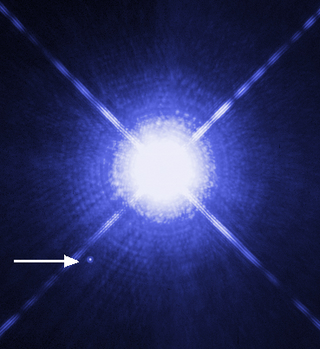The study of galaxy formation and evolution is concerned with the processes that formed a heterogeneous universe from a homogeneous beginning, the formation of the first galaxies, the way galaxies change over time, and the processes that have generated the variety of structures observed in nearby galaxies. Galaxy formation is hypothesized to occur from structure formation theories, as a result of tiny quantum fluctuations in the aftermath of the Big Bang. The simplest model in general agreement with observed phenomena is the Lambda-CDM model—that is, that clustering and merging allows galaxies to accumulate mass, determining both their shape and structure. Hydrodynamics simulation, which simulates both baryons and dark matter, is widely used to study galaxy formation and evolution.

A white dwarf is a stellar core remnant composed mostly of electron-degenerate matter. A white dwarf is very dense: its mass is comparable to the Sun's, while its volume is comparable to the Earth's. A white dwarf's low luminosity comes from the emission of residual thermal energy; no fusion takes place in a white dwarf. The nearest known white dwarf is Sirius B, at 8.6 light years, the smaller component of the Sirius binary star. There are currently thought to be eight white dwarfs among the hundred star systems nearest the Sun. The unusual faintness of white dwarfs was first recognized in 1910. The name white dwarf was coined by Willem Luyten in 1922.

Synchrotron radiation is the electromagnetic radiation emitted when relativistic charged particles are subject to an acceleration perpendicular to their velocity. It is produced artificially in some types of particle accelerators or naturally by fast electrons moving through magnetic fields. The radiation produced in this way has a characteristic polarization, and the frequencies generated can range over a large portion of the electromagnetic spectrum.

A radio galaxy is a galaxy with giant regions of radio emission extending well beyond its visible structure. These energetic radio lobes are powered by jets from its active galactic nucleus. They have luminosities up to 1039 W at radio wavelengths between 10 MHz and 100 GHz. The radio emission is due to the synchrotron process. The observed structure in radio emission is determined by the interaction between twin jets and the external medium, modified by the effects of relativistic beaming. The host galaxies are almost exclusively large elliptical galaxies. Radio-loud active galaxies can be detected at large distances, making them valuable tools for observational cosmology. Recently, much work has been done on the effects of these objects on the intergalactic medium, particularly in galaxy groups and clusters.
In astroparticle physics, an ultra-high-energy cosmic ray (UHECR) is a cosmic ray with an energy greater than 1 EeV (1018 electronvolts, approximately 0.16 joules), far beyond both the rest mass and energies typical of other cosmic ray particles.

Carlyle Smith Beals, FRS was a Canadian astronomer.

A pulsar wind nebula, sometimes called a plerion, is a type of nebula sometimes found inside the shell of a supernova remnant (SNR), powered by winds generated by a central pulsar. These nebulae were proposed as a class in 1976 as enhancements at radio wavelengths inside supernova remnants. They have since been found to be infrared, optical, millimetre, X-ray and gamma ray sources.
Fermi acceleration, sometimes referred to as diffusive shock acceleration, is the acceleration that charged particles undergo when being repeatedly reflected, usually by a magnetic mirror. It receives its name from physicist Enrico Fermi who first proposed the mechanism. This is thought to be the primary mechanism by which particles gain non-thermal energies in astrophysical shock waves. It plays a very important role in many astrophysical models, mainly of shocks including solar flares and supernova remnants.
In astronomy, the intracluster medium (ICM) is the superheated plasma that permeates a galaxy cluster. The gas consists mainly of ionized hydrogen and helium and accounts for most of the baryonic material in galaxy clusters. The ICM is heated to temperatures on the order of 10 to 100 megakelvins, emitting strong X-ray radiation.

In astronomy, an intermediate polar is a type of cataclysmic variable, binary star system with a white dwarf and a cool main-sequence secondary star. In most cataclysmic variables, matter from the companion star is gravitationally stripped by the compact star and forms an accretion disk around it. In intermediate polar systems, the same general scenario applies except that the inner disk is disrupted by the magnetic field of the white dwarf.

In astronomy, a Hubble bubble would be "a departure of the local value of the Hubble constant from its globally averaged value," or, more technically, "a local monopole in the peculiar velocity field, perhaps caused by a local void in the mass density."
Steven Jay Schwartz is a Professor of Space Physics at Imperial College London. He was awarded the Chapman Medal of the Royal Astronomical Society in 2006 "in recognition of his pioneering work in solar terrestrial physics and space plasma physics". In 2009, he became the Head of the Space and Atmospheric Physics Group at Imperial College London.
The Etherington's distance-duality equation is the relationship between the luminosity distance of standard candles and the angular diameter distance. The equation is as follows: , where is the redshift, is the luminosity distance and the angular-diameter distance.
Nadia Zakamska is a Russian-American astronomer who is a professor at Johns Hopkins University.

Alan R. Duffy is a professional astronomer and science communicator. He was born in England, raised in Northern Ireland, and is currently based in Australia. He is a professor at the Centre for Astrophysics and Supercomputing at Swinburne University of Technology, and is the Lead Scientist at the Royal Institution of Australia.
Benedetta Ciardi is an Italian astrophysicist.

NGC 4316 is an edge-on spiral galaxy located about 70 million light-years away in the constellation Virgo. It was discovered by astronomer Wilhelm Tempel on March 17, 1882. NGC 4316 is a member of the Virgo Cluster and is classified as LINER and as a Seyfert galaxy.

Luke O’Connor Drury is an Irish mathematician and astrophysicist at the Dublin Institute for Advanced Studies (DIAS) with research interests in plasma physics, particle acceleration, gas dynamics, shock waves, and cosmic rays. He was President of the Royal Irish Academy from 2011 to 2014.
Erich Otto Ernst Rieger is a German astrophysicist who spent his research career at the Max Planck Institute for Extraterrestrial Physics (MPE) near Munich. He is notable for his 1984 discovery of the period of ~154 days in solar flares. Since the discovery, the period has been confirmed in most heliophysics data in the Solar System, including the interplanetary magnetic field, and has become known as the Rieger period (PR).









